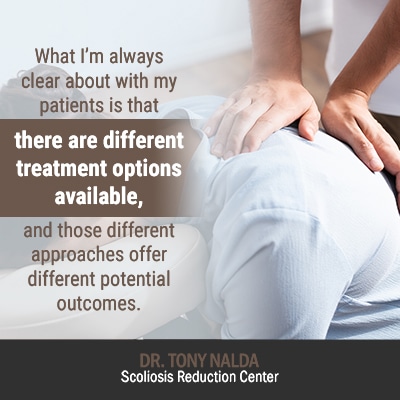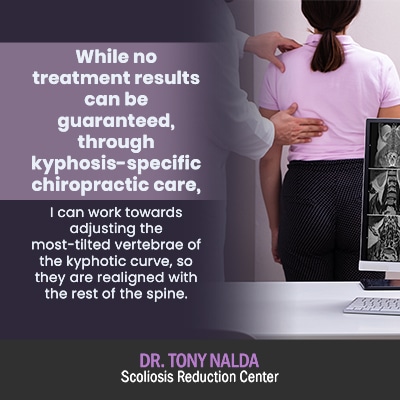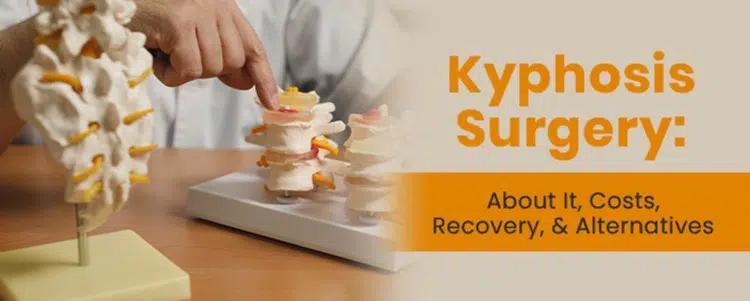each case of kyphosis is unique and requires a customized treatment plan moving forward, typically, nonsurgical treatment options for kyphosis include condition-specific chiropractic care, physical therapy, custom-prescribed home exercises, and corrective bracing. Surgical treatment for kyphosis typically involves a spinal fusion, and while any surgical procedure comes with its share of risks, spinal fusion is a procedure that should be considered carefully.
Kyphosis is defined as an excessive front-to-back spinal curvature that commonly gives the upper back a rounded appearance. While spinal fusion surgery can be used to correct kyphosis, it’s an invasive and risky procedure, and there are highly effective nonsurgical treatment options available. While many cases of kyphosis may not need treatment, those caused by abnormal vertebrae, such as congenital kyphosis, often require specific intervention.
Let’s start our discussion of kyphosis surgery by first defining the condition itself, plus touching on why the spine’s natural curvatures are so important.
Understanding Kyphosis and Spinal Compression Fractures
If a person were to look at a healthy spine from the back or front, it would appear straight, but looking at it from the sides, it would appear to have a soft ‘S’ shape.
The spine’s natural and healthy curves make it stronger, more flexible, and better able to absorb and distribute stress evenly throughout.
When there is a loss of one or more of the spine’s healthy curves, the biomechanics of the entire spine are disrupted. If left untreated, or not treated proactively, spinal conditions that involve a loss of the spine’s healthy curves can progress over time, often becoming more severe and causing more noticeable symptoms to develop.
The spine has three main sections: cervical (neck), thoracic (middle/upper back), and lumbar (lower back). Each section has its own characteristic curvature type.
Lordosis refers to the spine’s inward curvatures that bend forward towards the body’s center, while kyphosis refers to an opposite curvature type that bends backward, away from the body’s center.
While kyphosis can also affect the cervical spine, it most commonly develops in the thoracic spinal section, causing the characteristic hump on the upper back and giving the body a pitched-forward appearance.
While there is a natural range of curvature degree in healthy curves, once that curvature degree falls beyond a healthy range, that is when problems can occur and the diagnosis of a spinal condition, like kyphosis, can be given. Postural kyphosis is specifically linked to poor posture and can often be corrected through improvements in one’s posture.
If a person’s upper back develops a noticeable arch that gives the body a pitched-forward appearance, it can be due to an excessive
A natural range of kyphosis would fall between 20 and 40 degrees, with most diagnosed cases of kyphosis (aka hyperkyphosis), measuring at 50+ degrees.
So when a person has kyphosis, this means their upper back is excessively curved outwards, away from the body’s center, and once that diagnosis has been given, the next big question is how best to treat it moving forward. Scheuermann’s kyphosis is caused by abnormally shaped vertebrae and often requires different management approaches than other forms of kyphosis.
Before moving onto kyphosis surgery alternatives offered here at the , let’s focus on the main topic of kyphosis surgery and exploring the pros and cons of spinal fusion.
What is Kyphosis and When is Surgery Needed?
What is Kyphosis and When is Surgery Needed?
Kyphosis is a medical condition characterized by an excessive forward curve of the spine, which can cause discomfort, pain, and breathing difficulties. While many cases of kyphosis can be managed with noninvasive measures such as physical therapy and pain medications, surgery may become necessary in severe cases. Typically, surgery is considered when the spinal curvature exceeds 75 degrees or when the condition leads to significant pain, digestive issues, breathing difficulties, heart problems, neurological issues, or progressive complications. Understanding when surgery is needed is crucial for effective kyphosis treatment and ensuring the best possible outcomes for patients.
Surgical Treatment for Kyphosis: Spinal Fusion
While there are different types of surgical treatments for different types of kyphosis, spinal fusion is a highly-prevalent form of surgical treatment used to address a number of spinal conditions that involve a loss of the spine’s healthy curves.
Again, while no surgical procedure is 100-percent risk and complication-free, spinal fusion is a lengthy, invasive, and costly procedure that carries some heavy potential risks and side effects, and in many cases, it’s unnecessary.
There are different types of spinal fusion, but typically, the procedure involves fusing the most-tilted vertebrae (bones of the spine) together into one solid bone. Metal rods are commonly attached to the spine with screws to hold it in place throughout the fusion/healing process.
The goal of spinal fusion is to prevent an abnormal spinal curve from progressing (increasing in size); this is done by fusing the most-tilted vertebrae to eliminate movement in the area.
The procedure can last anywhere from 4 to 8+ hours, depending on how many vertebrae are involved and any unforeseen complications that emerge during surgery.
While each case is different and will depend on important variables such as patient age, health and fitness, condition severity, and whether or not any complications occurred, in general, people can expect a week-long recovery stay in the hospital and to return to normal activities within 4 to 6 weeks.

What I’m always clear about with my patients is that there are different treatment options available, and those different approaches offer different potential outcomes.
I feel that any surgical procedure should be carefully considered to ensure its potential benefits outweigh related risks and potential complications.
Some common risks and potential complications of spinal fusion include:
- Infection
- Excessive blood loss
- Adverse reaction to the hardware used
- Hardware malfunction
- Nerve damage
In addition, while spinal fusion can be successful at stopping further progression, there are no guarantees, and studies have shown that the loss of movement in the fused area of the spine equates to a loss in spinal flexibility that many patients find disappointing and disruptive to their daily lives.
Many patients also report an increase in post-surgical pain, and there is also a significant gap in the research and literature on the long-term effects of living with a fused spine 10, 20, and 30+ years down the road.
Surgical Approaches and Techniques
Surgery for kyphosis typically involves a spinal fusion procedure, where the curved portion of the spine is straightened and fused together using bone grafts and metal rods. The primary goal of this surgical treatment is to correct the deformity, relieve pain, and restore posture and ease of movement. Several surgical approaches and techniques can be employed to treat kyphosis, including:
- Posterior Arthrodesis: The most common approach, where the surgeon makes an incision in the back and uses metal rods and screws to straighten the spine.
- Anterior Surgery: This approach involves making an incision in the front of the body and removing the damaged disc material to increase flexibility in the spine.
- Combined Anterior-Posterior Surgery: This technique involves making incisions in both the front and back of the body to correct the deformity.
- Minimally Invasive Surgery: Utilizing smaller incisions and specialized instruments, this approach aims to minimize tissue trauma and promote faster recovery.
Each of these techniques has its own set of benefits and considerations, and the choice of approach depends on the specific needs and condition of the patient.
Risk Factors and Complications
Kyphosis surgery, like any surgical procedure, carries several risk factors and potential complications. These can include:
- Infection
- Blood clots
- Nerve damage
- Bone graft failure
- Hardware failure
- Respiratory problems
- Cardiac problems
- Neurological problems
It is essential to have a thorough discussion with your doctor about the benefits and risks of surgery to determine if it is the best option for your specific condition. Understanding these risk factors can help patients make informed decisions about their kyphosis treatment.
Cost of Spinal fusion
It’s very difficult to guide people on the cost of spinal fusion because it’s dependant on multiple variables that change from one person to the next: patient age, condition severity, amount of vertebrae involved, surgeon selected, length of surgery, surgeon fees, and of course, any unforeseen complications that increase the necessary recovery time spent in hospital can drive the cost up significantly.
On average, spinal fusion costs in the United States range from $140,000 to $175,000.
It’s also important, however, to remember that the costs of spinal fusion aren’t just monetary. As we’ve discussed, the procedure comes with its fair share of potential risks and complications.
While the procedure can be successful in straightening a crooked spine, the way it is achieved can come at the cost of the spine’s overall health and function, and this can impact the quality of life.
Fortunately, for those who have chosen to forego a surgical recommendation or simply want to explore less-invasive treatment options first, here at the Center, I offer highly effective kyphosis surgery alternatives.
Postoperative Care and Recovery
After kyphosis surgery, patients typically require several weeks of recovery time. During this period, it is essential to follow a comprehensive postoperative care plan to ensure proper healing and recovery. Key aspects of postoperative care include:
- Following a physical therapy program to promote healing and strengthen the back muscles.
- Taking pain medication as directed by your doctor to manage discomfort.
- Avoiding heavy lifting, bending, or strenuous activities to prevent strain on the spine.
- Wearing a back brace to support the spine while it heals.
- Attending follow-up appointments with your doctor to monitor progress and remove any sutures or staples.
Adhering to these guidelines can help ensure a smoother recovery and better long-term outcomes.
Long-Term Outcomes and Monitoring
The long-term outcomes of kyphosis surgery are generally positive, with most patients experiencing significant improvement in their symptoms and quality of life. However, it is essential to continue monitoring the condition to prevent any potential complications or progression of the deformity. Regular follow-up appointments with your doctor and adherence to a physical therapy program can help maintain a healthy spine and prevent future problems. Ongoing monitoring and care are crucial for sustaining the benefits of the surgical treatment and ensuring the best possible quality of life for patients.
By understanding the various aspects of kyphosis surgery, including when it is needed, the surgical approaches and techniques, potential risks, postoperative care, and long-term outcomes, patients can make informed decisions about their treatment options and work towards achieving the best possible results.
Kyphosis Surgery Alternatives
When it comes to kyphosis surgery alternatives, here at the Scoliosis Reduction Center®, I’m trained, certified, and experienced in multiple treatment modalities so that I can offer patients fully integrative and customized treatment plans.
As the nature of kyphosis is highly variable in terms of condition severity, spinal flexibility, and different types of kyphosis, it necessitates the crafting of patient-specific treatment plans moving forward.
Through a conservative chiropractic-centered approach, I prioritize the spine’s overall health and function by working towards achieving corrective results on multiple levels.
If I’m treating structural kyphosis, this is caused by a structural abnormality within the spine itself, and this means that, first and foremost, effective treatment has to impact the condition on a structural level.

While no treatment results can be guaranteed, through kyphosis-specific chiropractic care, I can work towards adjusting the most-tilted vertebrae of the kyphotic curve so they are realigned with the rest of the spine.
Through a variety of in-office therapies and custom-prescribed home exercises, I work closely with patients to increase their spinal and core strength. If the muscles surrounding the spine are loose, flexible, and strong, they are better able to support and stabilize the spine, and this is important when it comes to the spine’s ability to maintain its natural and healthy curvatures and alignment.
Through corrective bracing, I can work towards augmenting corrective results and providing the spine with optimal support.
I find a multifaceted treatment approach to be highly effective, especially when it comes to treating complex spinal conditions that vary from one patient to the next.
Conclusion
When it comes to kyphosis surgery, I encourage patients and their families to do their own due diligence in researching alternative forms of kyphosis treatment.
As mentioned, different treatment approaches offer patients different potential outcomes, so it’s very important to ensure that a patient’s treatment expectations are fully aligned with the realities of their potential outcomes.
As an excessive backward curvature of the upper back, kyphosis can cause postural deviation that includes a noticeable arch on the upper back and causes a roundback appearance.
While some patients choose surgical treatment options, such as spinal fusion, for their kyphosis, here at the Scoliosis Reduction Center®, I work towards achieving corrective results that help patients avoid the cost, the need, and the hardships associated with invasive surgical procedures.





